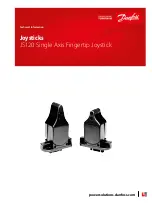
Parameters
U600 User’s Guide
C-18
Aerotech, Inc.
Version 1.4
EXAMPLE:
ENABLE X Y
; ENABLE the X and Y drives
If your DRIVE won’t enable, it could be due to one of several problems.
1.
A fault is present (Drive Fault, etc.)
2.
You have assigned its DAC (D2A) channel to two or more axes within the Axis
Configuration Wizard.
C.2.32.
ECHO
This is a "dummy" parameter. It has no effect on the operation of the controller, but may
be used by the user for storage of data. It is essentially equivalent to an axis variable.
C.2.33.
EXTR2DSCL
The EXTR2DSCL axis parameter is used to extend the range of the servo loop
parameters for dual loop systems using a resolver for velocity feedback.
For example, if the range of the PGAIN parameter is inadequate (i.e., 1 is too little and 2
is too much), increase the EXTR2DSCL parameter to an arbitrary value such as 128.
Then increase the encoder lines per revolution parameter within the axis configuration
proportionally by 128, (i.e.; enter a value 128 times greater). This will allow a more
reasonable range for the setting of the axis servo parameters (KP, KI, and PGAIN).
C.2.34.
FAULT
This axis parameter indicates axis faults that have occurred on an axis, since the last time
the axis faults were cleared, by reading this parameter. You can also clear axis faults, by
writing to this parameter.
When an axis fault occurs, the UNIDEX 600 MMI will flash an error message in the
position tracking display of the Run or Manual pages.
This parameter is a bit mask, where each bit corresponds to a specific axis fault that may
occur. A zero value indicates that no axis faults have occurred, and since the parameter is
bit-mapped, non-zero values for this parameter reflect the occurrence of multiple axis
faults. When a fault occurs, the appropriate bit (refer to Table C-3 for Axis Fault Bit
Definitions) is ‘anded’ into the FAULT parameter value, and will remain set until cleared.
The user may clear faults by writing to the FAULT axis parameter. When writing to the
FAULT parameter, the UNIDEX 600 attempts to clears all faults whose bits are set in the
value written to the parameter. Fault bits set to zero are not cleared. For example, If the
FAULT parameter value is “10”, the user could write “10” to the FAULT parameter, to
clear all active faults (set FAULT back to zero). If the user wrote “8” to the FAULT
parameter, it would then read “2.” The user should keep in mind that if the condition
causing the axis fault is still present, the axis fault will immediately reoccur, so that it will
appear as though the fault did not clear.
Содержание UNIDEX 600 Series
Страница 19: ...Table of Contents U600 User s Guide xviii Aerotech Inc Version 1 4...
Страница 27: ...Preface U600 User s Guide xxvi Aerotech Inc Version 1 4...
Страница 163: ...AerPlot U600 User s Guide 6 6 Aerotech Inc Version 1 4...
Страница 169: ...AerReg U600 User s Guide 8 4 Aerotech Inc Version 1 4...
Страница 177: ...AerPlotIO U600 User s Guide 10 4 Aerotech Inc Version 1 4...
Страница 179: ...Filter U600 User s Guide 11 2 Aerotech Inc Version 1 4...
Страница 219: ...PrmSetup U600 User s Guide 13 2 Aerotech Inc Version 1 4...
Страница 223: ...Glossary of Terms U600 User s Guide A 4 Aerotech Inc Version 1 4...
Страница 353: ......
















































